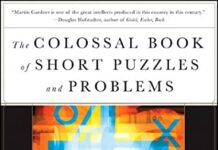
Ebook Info
- Published: 2012
- Number of pages: 207 pages
- Format: PDF
- File Size: 3.88 MB
- Authors: Martin Gardner
Description
Since the publication of Einstein’s Special Theory of Relativity in 1905, the discovery of such astronomical phenomena as quasars, pulsars, and black holes — all intimately connected to relativity — has provoked a tremendous upsurge of interest in the subject.This volume, a revised version of Martin Gardner’s earlier Relativity for the Million, brings this fascinating topic up to date. Witty, perceptive, and easily accessible to the general reader, it is one of the clearest and most entertaining introductions to relativity ever written. Mr. Gardner offers lucid explanations of not only the special and general theories of relativity, but of the Michelson-Morley experiment, gravity and spacetime, Mach’s principle, the twin paradox, models of the universe, and other topics. A new Postscript, examining the latest developments in the field, and specially written for this edition, is also included. The clarity of the text is especially enhanced by the brilliant graphics of Anthony Ravielli, making this “by far the best layman’s account of this difficult subject.” — Christian Science Monitor.
User’s Reviews
Reviews from Amazon users which were colected at the time this book was published on the website:
⭐I recently read a handful of books on relativity, and I rank them as follows:Highly recommended introductory works: * Relativity Simply Explained by Martin Gardner — best introductory book. *
⭐(chapters 2 & 3) by Brian Greene — extremely lucid, but not as in-depth as Gardner’s book — possibly the best if you want a shorter introduction. *
⭐by Walter Isaacson, chapter 6 (special relativity) & chapter 9 (general relativity) — not just a great biography, also a very lucid explanation of Einstein’s ideas. *
⭐(chapters 2 & 3) by Brian Greene — a discussion of general relativity & the nature of spacetime.Further reading: *
⭐by Mook & Vargish — great introduction to Newton, along with great sections on what high-speed objects look like and a great section on how Maxwell’s equations of electromagnetism relate to relativity. *
⭐by Lewis Carroll Epstein — a good additional book to read, if you want to delve more into truly understanding how it works. Not recommended as an introduction. * Relativity: A Very Short Introduction by Russell Stannard — might be a good introduction, but not as lucid as some of the books above. * Relativity by Albert Einstein — not recommended. It’s great if you want to see how Einstein explained it, but it is generally not a good introduction. Cumbersome, difficult, and boring.Relative to the books above, Gardner’s book gives the best history of the developments leading up to the theory of relativity. It gives numerous examples of the principle of relativity, which helps the reader ease into thinking in relative terms. It mentions a thought experiment about relativity by Poincare and a short story about relative changes by HG Wells. So it gives you a sense of what was going on prior to Einstein. None of the other books listed did that, or not as effectively.It provides a history of ether and the efforts to preserve the concept of ether (which leads into the development of the theory of relativity). None of the other books listed did that. I found all of the pre-history to be essential to truly understanding relativity.It does a great job explaining relativity in a lucid, straightforward manner with numerous examples. I think he explained the equivalence principle, which led to general relativity, better than any of the books above.A reader could reasonably skip chapters 10-12 (on cosmology), which are out of date and which are likely covered better elsewhere. They still make interesting reading, especially the chapter on the shape of the universe, but they are not essential to understanding relativity.This book is not perfect, and there are probably concepts that for some readers are better explained in other books. But, relative to the books listed above, I found it to be the best introductory book. Anyone interested in truly understanding relativity will likely want to read several books, in order to view it from multiple frames of reference.If you’d like larger print and/or hardcover, the first edition of this book is just as good —
⭐. My only complaint about Relativity Simply Explained is that the text is a little small.Enjoy your studies of this fascinating subject!cheers:)
⭐If you know nothing, then this book is an easy introduction to the history & consequences of relativity.If you know some of it already and are looking for more exposure to the nuances and math in order to build a more comprehensive understanding, then this book may be disappointingly basic. There are some Web pages out there more satisfying…
⭐Book is very well written. It gave me a very good feel for relativity. The graphics were fantastic. While these were on or adjacent to the narrative, just a few times I found a disconnect between the written descriptions and the graphics.Human beings do not live the quantum physics/relativity reality- the reality of this world. We live in a world that we perceive based on our limited senses and experiences. The same as a fish-it does not know what it is to live on land.For anyone with a basic science back ground, this book expands his knowledge taking him from what he knows to what he should know.
⭐If you are looking for a comprehensive book to understand the nuances of Relativity theory, this isn’t for you. However, if you are not mathematically inclined, or don’t wish to dive into the math or physics just yet, this is a excellent choice.This was the first book that I read on the subject of Einstein’s theory. I found it entertaining and actually fun to read. I have not read any of Gardner’s other books, but his writing style in this one makes for an easy read. It does not feel like you are reading much of a physics books at all.Furthermore, the illustrations not only are well done, but they make it easier to understand the principles being explained.If you are looking to know the basics of this theory, this is best book to own. Simple to read, good explanations, uncomplicated. If you are looking for more depth, than you will certainly move on to another book after this, but this is an excellent one to start with.
⭐A pity none of the modern popular writers can come anywhere near to this book in the clarity of its explanations. At least having read this, I feel more willing to tackle some of the badly written but more detailed recent books on the subject.
⭐Present for my grandson who needed to read it before his interview for Cambridge.Received an offer so well worth the buy.
⭐very disappointed in the kindle edition – formula so tiny they’re difficult to read – obvious transcribing errors
⭐Very nice, better explanation Thant other books
⭐It can’t get simpler than this.
Keywords
Free Download Relativity Simply Explained (Dover Classics of Science & Mathematics) in PDF format
Relativity Simply Explained (Dover Classics of Science & Mathematics) PDF Free Download
Download Relativity Simply Explained (Dover Classics of Science & Mathematics) 2012 PDF Free
Relativity Simply Explained (Dover Classics of Science & Mathematics) 2012 PDF Free Download
Download Relativity Simply Explained (Dover Classics of Science & Mathematics) PDF
Free Download Ebook Relativity Simply Explained (Dover Classics of Science & Mathematics)

